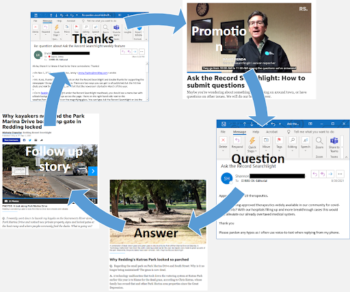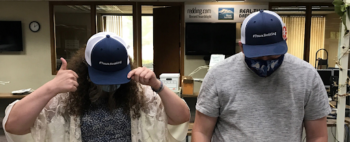How a reader-oriented ask-the-newsroom effort brought digital subscribers to the Redding Record Searchlight
Michele Chandler, Jessica Skropanic, David Benda, Jenny Espino and Silas Lyons, Record Searchlight,
Record Searchlight journalists celebrate with cake after reaching 4,000 digital subscriptions just before the start of the coronavirus pandemic in March 2020. The newspaper had grown digital subscriptions to nearly 6,000 by the time it completed its participation in the Poynter Table Stakes program in 2020-2021.
Here’s an idea to steal and adapt: Accelerate digital subscription growth by encouraging reader participation and answering reader questions.This is a series on Better News to a) showcase innovative/experimental ideas that emerge from the Knight-Lenfest Newsroom Initiative and b) share replicable tactics that benefit the news industry as a whole. This “win” comes from Michele Chandler, Jessica Skropanic and David Benda, senior reporters; and Jenny Espino, local editor, all of the Redding (Calif.) Record Searchlight; and Silas Lyons, director of the Center for Community Journalism in the USA TODAY Network. The Record Searchlight participated in the Poynter Table Stakes program in 2020-2021.
Question: What communities do you serve and what can you tell us about the history of your organization?
A: The Record Searchlight is the leading news source in Shasta County and neighboring rural counties in far Northern California. The newspaper traces its modern history to the first edition of the Redding Record in 1938, when work began on the construction of Shasta Dam. The R-S’s local coverage and investigative journalism shape the community conversation around key issues such as homelessness, wildfire prevention, law enforcement, growth, and childhood trauma and education.
Q: What problem were you trying to solve, and why was solving the problem strategically important for your organization?
A: Our team’s challenge was to regain or establish trust with readers with whom it was lacking. We see that as critical on our path to a sustainable future.
The Redding Record Searchlight a) tackled the issue of trust with its conservative audience and b) accelerated digital subscription growth by encouraging reader participation and offering a reader-driven franchise called “Ask the Record Searchlight.”
Q: How is this approach related to Table Stakes (e.g. one of the 7 Table Stakes and/or an outgrowth of the Knight-Lenfest initiative, etc.)?
A: This initiative is related to Table Stake No. 1 (“Serve targeted audiences with targeted content”) and Table Stake No. 2 (“Publish on the platforms used by your targeted audiences”).
Our audience is at the center of Ask the Record Searchlight. We not only invite them to become involved in and help shape our coverage. We seek them out on social media, contact them directly via email and remind them through regular coverage how they can reach us.

In this diagram, the Redding newspaper explains the life cycle of a question once journalists receive it through the newsroom-wide initiative, Ask the Record Searchlight.
Q: How did you go about solving the problem?
A: It all started with the team’s business reporter saying he had seen a sports chat between a reporter and his followers in The Oklahoman in Oklahoma City. We thought it could be tailored to our community.
Helping us along the way were the team’s participation in the Trusting News Project and the Re-Engaging the Right Project and a pair of surveys we created to gauge news coverage satisfaction and to measure trust. The message from readers was that they were looking for more local coverage.
To date, about 700 questions have poured in from the community via the Live Chats we held in the first year of the initiative, emails, Facebook messages and direct reader contact with the journalists.
The team has answered well over 300 questions and published about 70 stories, including some that were enterprise in nature.
Additionally, the team developed a sentiment analysis tool (see page 10 of our Table Stakes booklet) to measure reader comments posted with our content, on Facebook or via email. To that end, we created a five-point scale to assess the tone used and who the comment was directed at. During a three-month period while participating in Table Stakes, the newspaper’s score grew from an equivalent of a C+ to an A-.
Q: What worked?
A: From January to November 2021, the newspaper saw 24% growth in digital subscriptions, reaching nearly 6,000. About 25% of that growth could be directly attributed to Ask the Record Searchlight. The newsroom-wide initiative earned recognition as the “Biggest Win” of the Poynter Institute-led Table Stakes cohort that year.
The most questions come to Ask the R-S when we don’t have a central theme. Asking for questions related to consumer affairs or wildfires, for example, brought in few direct questions (although some questions submitted at other times were consumer or wildfire related).
By casting a wide net, we also discovered topics of blockbuster interest, including anything to do with the controversial Bethel megachurch, crime (including the Sherri Papini kidnapping case) health care issues and the expansion of the Shasta County Jail.
Q: What didn’t work?
A: Three things.
First, we tried to get print readers to embrace our online platforms by publishing print-only stories on how subscribers can activate their digital accounts. Some registered their disapproval and said we were trying to get rid of the hard copy of the newspaper. Overall, we did not see a significant change in digital activations. Some readers still call the Record Searchlight to ask their questions.
Second, our initial attempt to recommend readers follow certain themes – to guide their question topics – fell flat. Readers asked questions on themes we didn’t expect, and it broadened our understanding of topics that interest them.
Third, we didn’t have enough staff to do the additional podcast/audio project we had hoped to do when we embarked on our challenge. That may change in the future, but it’s on hold for now.
Q: What happened that you didn’t expect?
A: Three things happened that threw a wrench in our ability to answer the number of questions and publish as often as we initially planned.
First, the project grew faster than expected. We received more questions than predicted, and – being a small newsroom – had to prioritize which questions we had time to answer.
Second, several months into the project, in summer 2021, Northern California experienced a far more active fire season than usual. This pulled much of our staff’s time away from the project to attend to fire coverage.
Third, restrictions related to the COVID-19 pandemic canceled our plans to have an open house and invite readers to mingle with us in person. We’re still exploring how we might be able to organize an event in 2023.
Q: What would you do differently now? What did you learn?
A: Main lesson: Our Ask the R-S content doesn’t have to be massive to have impact.
Our first few Live Chats had five or more items, plus associated story links and photos. That’s because at the start, continuously boosting engagement time was a goal we were working on with our Poynter mentors.
We learned several lessons from that exercise. The main takeaway was that the amount of reporting and writing needed to keep up a pipeline of long Live Chats every other Thursday and static Mailbag pieces every other Tuesday was not sustainable, given our small staff and unpredictable breaking news. We twice had to suspend the effort due to wildfire coverage.
After about nine months, we cut the length of the Q&A’s to fewer than three items, with some one-item pieces of high interest being presented as stand-alone stories. The headline indicated the topic had been pursued directly because of a question to Ask the R-S, letting readers know we were still listening to them.
We also changed to a unified branding of our reporting to fall under our Ask the Record Searchlight initiative and stopped using the Live Chat or Mailbag designations.
We learned that having Ask the R-S coverage every other Thursday, supplemented by other stories on whatever days they were completed, was doable. This has kept the Ask the R-S franchise consistent and attracted new subscribers.
Q: What advice would you give to others who try to do this?
A: Be ambitious with your project, but also be realistic as to what you can keep going long term. Consistency is of immense importance so the community can see what you’re doing and know they can count on your features to appear week after week.
If your staff is small, consider presenting shorter Q&A’s more frequently.
Also, don’t be afraid to try something new! But be ready to pull the plug if too many obstacles block what you can achieve. The idea can always be retooled and tried again later.
Also, make sure your entire staff is aware of what’s being done and has ownership of why it’s important and how they can temporarily step in to make it work, if necessary.

Record Searchlight reporters Nada Atieh (left) and Ethan Hanson pose with their Team Redding trucker hats at the Redding newspaper’s former office.
And, if you deem questions to be of low interest, either answer the reader directly with an email or put it on the back burner for when you are really scrounging for questions.
Q: Is there anything else you’d like to add?
A: In 2022, we’ve been putting Ask the R-S content behind the subscriber-only paywall and have watched subscription orders climb. Our next step is to launch a newsletter. We continue to work toward making this feature a profitable, full-blown franchise with subscriber-only content, an engaged newsletter audience and at some point, in-person events.